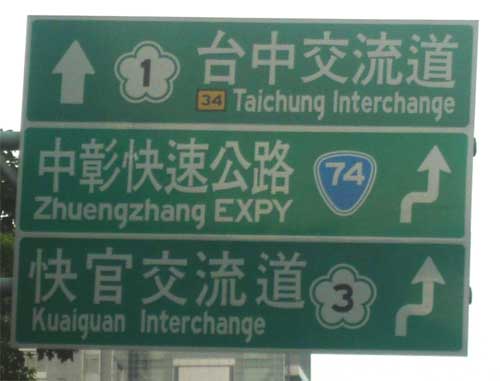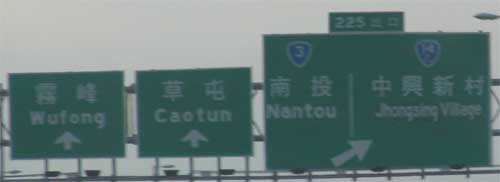This isn’t much of a story, really. But since it talks, however vaguely, about the messy romanization situation in Taizhong and since I haven’t put up anything lately in Pinyin itself, I decided to go ahead and post it.
Just don’t expect any useful news herein, unless you’d be surprised to hear that Taizhong’s street signs are a mess.
Táizhōng Shì lùpái suǒ shǐyòng de Yīngwén pīnyīn qiānqíbǎiguài, pīnyīnfǎ jìyǒu Tōngyòng, Hànyǔ, zhùyīn fúhào dì-èrshì, Wēituǒmǎ pīnyīn, děng, jiù yǒu mínzhòng xiàng běnbào bào liào, zhǐchēng zhèxiē lùpái ràngrén kàn de “wùshàsha,” wàiguó guānguāngkè gèng zhǐnéng gān dèngyǎn.
Yǐ Táizhōng Shì nánqū Wǔ-quán Nánlù [i.e, “the Five Branches of Government South Road”] de xīn-jiù lùpái láishuō, jiù yǒu lùpái shì cǎiyòng Wēituǒmǎ pīnyīn, yīncǐ “權” zì shǐyòng chuan, ér gānggāng wángōng de xīnshì lùpái “權” zì zéshì shǐyòng cyuan, shìwéi Tōngyòng Pīnyīn, rán’ér xiànzài Táizhōng Shìzhèngfǔ zǎoyǐ quánmiàn gǎiyòng Hànyǔ Pīnyīn, “權” zì yīnggāi shì quan cái zhèngquè.
Lìngwài, zài nánqū xīng dàlù de lùpái, jiù yǒu lùpái “興” zì de pīnyīn wéi hsing, shì shǐyòng Wēituǒmǎ pīnyīn, rìqián gāi lùduàn yě gēnghuàn xīnshì lùpái shàng, shìyǐ Hànyǔ Pīnyīn jiāng “興” zì pīnyīn wéi xing, dàn liǎng ge lùpái dōu xuánguà zài lùkǒu, ràngrén kàn de “wùshàsha.”
Zhēnduì Táizhōng Shì lùpái suǒ shǐyòng Yīngwén pīnyīn gèzì bùtóng de qíngkuàng, Táizhōng Shìzhèngfǔ Jiāotōngchù jiāotōng guīhuà kē biǎoshì, zài gègè niándài suǒ xīngjiàn de lùpái shǐyòng bùtóng de pīnyīn fāngshì, cái huì zàochéng xiànjīn hùnluàn de qíngkuàng, mùqián Táizhōng Shì yǐjing quánmiàn cǎiyòng Hànyǔ Pīnyīn, wèile jiějué cǐ yī wèntí, yóu Táizhōng Shìzhèngfǔ dūshì fāzhǎn chǔyǐ “chéng-xiāng xīnfēngmào” de jīngfèi, jìnxíng tǒngyī lùpái pīnyīn de gōngzuò. Zài Wǔ-quán Nánlù de xīn lùpái fāngmiàn, yuánběn yīnggāi shǐyòng Hànyǔ Pīnyīn, dàn chéngbāoshāng què fāshēng cuòwù, mùqián yǐjing yāoqiú gǎijìn; zhìyú zài xīng dàlù fāngmiàn, yě huì yāoqiú chéngbāo yèzhě jiāyǐ gǎizhèng.
source: Lù míng pīnyīn luànzāozāo — kàn dé rén wùshàsha (路名拼音亂糟糟 看得人霧煞煞), Zìyóu Shíbào (Liberty Times), March 21, 2009




